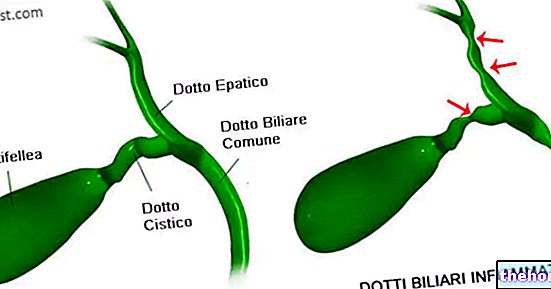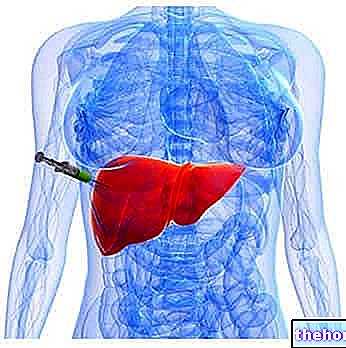Causes and Risk Factors
Why do biliary tract and gallbladder stones form and what are the risk factors?
The bile produced by the liver contains several components in a balanced way; however, it may happen that this equilibrium is broken, favoring the precipitation of cholesterol and / or of the bile pigments contained therein.
Gallbladder stones can form from a congenital defect of the liver that produces bile that is too high in cholesterol and low in bile salts, or from a gallbladder that tends to concentrate too much. There are also minor concomitant factors that can favor its precipitation.
Alongside all these predispositions of genetic origin, there are others that are acquired by the individual due to a lifestyle that is not exactly balanced:
- Rapid weight loss: an "excessive caloric restriction or prolonged fasting facilitate the formation of stones by slowing down the motility of the gallbladder and prolonging the stay of the bile inside it.
- Obesity: the obese tends to secrete more cholesterol and less bile salts and to have less emptying of the gallbladder. For this reason, the development of stones in the gallbladder occurs three to four times more frequently in obese people than in those of normal weight.
- Female sex, pregnancy (especially the third trimester), birth control pills, estrogen replacement therapies: in response to the increase in estrogen concentration, the secretion of cholesterol also increases, which facilitates the formation of stones.
- Unbalanced diet: the appearance of gallbladder stones can be related both to a diet excessively rich in lipids (in a general sense, therefore, rich in fatty acids but also in cholesterol, etc.), or too poor (hypolipidic diet), or even , too restrictive diets started abruptly or, worse, fasting. For this reason, in general, it is advisable to always use common sense, following a "healthy and balanced diet."
For further information: Nutrition and Gallstones
Other possible risk factors
Additional risk factors for the formation of gallbladder stones are represented by:
- Some rare inflammatory bowel diseases, such as ulcerative colitis and Crohn's disease;
- The familiarity of the pathology (the risk of gallbladder stones is higher in the children of subjects with the same disease);
- Diabetes;
- Hypercholesterolemia, hyperlipidemia (even if there are conflicting opinions among doctors);
- High levels of triglycerides in the blood
- Population of belonging: Native Americans and Scandinavians are genetically more susceptible to cholelithiasis;
- Over 40 years old: advanced age is associated with a greater lithogenicity of bile;
- Periods of oral hypo-nutrition;
- High number of pregnancies: the risk increases from 8% in women who have had only one pregnancy to 18% in women with more than three pregnancies;
- Hemolytic anemia, sickle cell anemia: in this case the risk of gallstones is high even in children or young subjects.
REMEMBER THAT: up to 10-15% of the population are carriers of gallbladder stones but only 20-40% develop the typical symptoms of the disease.
The prevalence of biliary lithiasis increases with age and goes from 5% around the age of 30 to more than 25% in the over 60s.
Symptoms
What Symptoms Can Gallbladder Stones Cause?
For further information: Gallbladder Stones Symptoms
Gallbladder stones are a fairly common disorder. As often happens with many pathologies, even gallbladder stones may not show signs of their presence (asymptomatic stones). Other times, however, they can generate serious disorders that require the intervention of the doctor and in the most serious cases of the surgeon.

The symptoms of gallbladder stones, if any, are mainly attributable to biliary colic. In the past, several researchers have tried to link the presence of these pebbles with vague ailments such as nausea, abdominal pain or bitter mouth. However, no studies have confirmed the "existence of a direct relationship between these nonspecific symptoms and the presence of" liver "stones (an improper synonym for" gallbladder stones "which is used in common parlance).
This does not, of course, mean that some patients affected by gallbladder stones may complain of digestive difficulties and experience symptoms such as postprandial heaviness, nausea, vomiting and visceral pain.
In most cases, gallstones is therefore asymptomatic: it does not cause particular disorders and, if it has not already caused problems in the past, the chances of causing biliary colic are very low.
Speaking in purely statistical terms, about 60-80% of gallbladder stone carriers are asymptomatic; of these every year 3% will become symptomatic (20-40% in 10 years). Another 5-18% will require an emergency cholecystectomy for complications related to the presence of stones.
Other articles on "Stones of the Biliary Tract and Gallbladder: Causes and Symptoms"
- Gallbladder stones, gallbladder stones
- Biliary colic and complications
- Diagnosis and treatment
- Gallbladder Stones - Medicines to Treat Gallbladder Stones
- Nutrition and Gallstones
- Diet and Gallbladder Stones




























